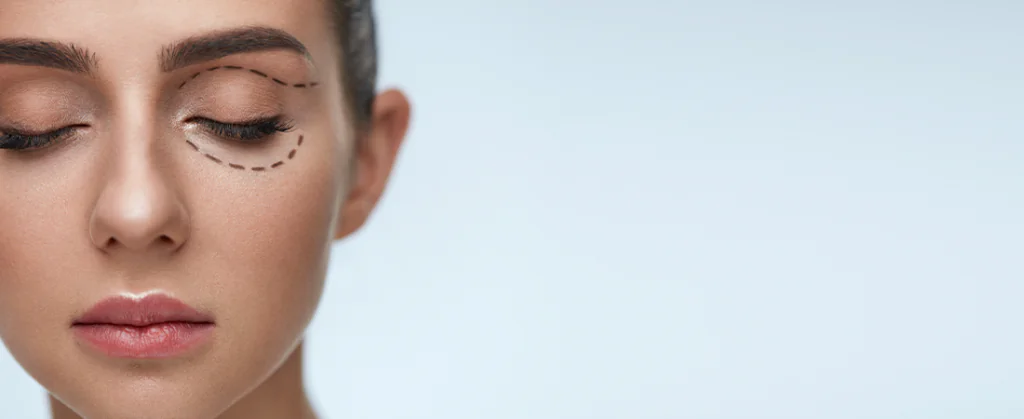Cosmetic eye surgery is a transformative option for individuals seeking to enhance the appearance of their eyes while addressing functional concerns. Procedures such as eye bag removal, cosmetic eye lift, and plastic surgery for double eyelid are highly popular. However, as with any surgical procedure, it is essential to understand the potential side effects and risks before proceeding.
This guide delves into the risks, benefits, and considerations associated with cosmetic eye surgery to help you make an informed decision.
What is Cosmetic Eye Surgery?
Cosmetic eye surgery encompasses a range of surgical procedures designed to improve the aesthetics and functionality of the eyes. These surgeries target issues such as droopy eyelids, under-eye bags, or the desire for a more defined eyelid crease.
Common types of cosmetic eye surgeries include:
Eye Bag Removal: Eliminates puffiness and under-eye bags caused by excess fat or sagging skin.
Plastic Surgery for Double Eyelid: Creates a defined crease in the upper eyelid for individuals seeking a more pronounced eyelid fold.
Cosmetic Eye Lift: Lifts droopy eyelids, reducing sagging skin and restoring a youthful appearance.
Each procedure is tailored to the patient’s unique needs and performed precisely by an oculoplastic surgeon.
How to Prepare for Cosmetic Eye Surgery?
Proper preparation can ensure a smoother experience and better outcomes:
- Consultation: Meet with an experienced oculoplastic surgeon to discuss your goals and undergo a thorough examination.
- Medical History: Provide a complete history of your health, including any medications, allergies, or previous surgeries.
- Pre-Surgery Instructions: Follow your surgeon’s guidelines, such as avoiding blood-thinning medications and maintaining a healthy lifestyle.
Benefits of Cosmetic Eye Surgery
Cosmetic eye surgery offers both aesthetic and functional benefits:
- Enhanced Appearance: Eye surgery for droopy eyelids or eye lifts rejuvenate tired-looking eyes, giving them a refreshed and youthful appearance.
- Improved Vision: Excess skin or drooping eyelids can obstruct vision, and surgery can restore a clearer field of sight.
- Boosted Confidence: Achieving a desired look can enhance self-esteem and overall quality of life.
- Long-Lasting Results: Unlike non-invasive treatments, cosmetic eye surgeries provide more permanent improvements.
Possible Side Effects of Cosmetic Eye Surgery
While generally safe when performed by a qualified oculoplastic surgeon, cosmetic eye surgeries can have potential side effects, including:
Swelling and Bruising
Post-operative swelling and bruising around the eyes are common and typically subside within a week or two. Ice packs and prescribed medications can help alleviate discomfort.
Dry Eyes
Some patients may experience temporary dryness following procedures like cosmetic eye lift or eye bag removal. Lubricating eye drops are often recommended to keep the eyes moisturised during recovery.
Infection
Although rare, any surgical procedure carries a risk of infection. Proper post-operative care and hygiene can minimise this risk.
Scarring
Surgical incisions may leave small scars, but these are usually minimal and fade over time, especially when placed strategically along natural creases.
Sensitivity to Light
Patients may temporarily feel sensitive to light following surgery. Wearing sunglasses and avoiding direct sunlight can help manage this side effect.
Also Read: All About Oculoplasty
Risks Associated with Cosmetic Eye Surgery
It’s essential to understand the risks involved in cosmetic eye surgery to make an informed decision:
Asymmetry
In some cases, the results may appear uneven, with one eyelid or eye looking slightly different from the other. This can often be corrected with minor revisions.
Difficulty Closing Eyes
Eye surgery for droopy eyes can sometimes result in difficulty fully closing the eyes if too much skin or tissue is removed. This is why it’s crucial to consult an experienced oculoplastic surgeon.
Bleeding and Hematoma
While uncommon, bleeding beneath the skin (hematoma) may occur. This risk is typically minimised with proper surgical techniques and post-operative care.
Vision Changes
In rare cases, temporary or permanent vision changes may occur due to swelling or complications during the procedure. Close monitoring by your surgeon helps mitigate this risk.
Allergic Reactions
Some patients may experience allergic reactions to anaesthesia, medications, or surgical materials. Informing your surgeon of any known allergies beforehand is critical.
Eye Lift Cost and Factors Influencing It
The eye lift cost or the cost of procedures like eye bag removal varies based on several factors:
- Complexity of the Procedure: The extent of the surgery required to achieve the desired outcome.
- Surgeon’s Expertise: Skilled oculoplastic surgeons with extensive experience may charge higher fees.
- Facility and Location: Costs can vary depending on the clinic’s location and the technology used.
- Additional Procedures: Combining surgeries, such as a cosmetic eye lift and under-eye rejuvenation, may increase the overall cost.
During your consultation, your surgeon will provide a detailed breakdown of the costs and guide you through the available options.
Final Words
Cosmetic eye surgery can enhance the appearance and functionality of your eyes, restoring confidence and improving quality of life. However, understanding the potential side effects and risks is vital for making informed decisions.
Take the first step toward healthier, more beautiful eyes Book an Appointment with Centre for Sight in India!
Frequently Asked Questions
What is cosmetic eye surgery?
Cosmetic eye surgery enhances the appearance of the eyes through procedures like eyelid surgery or eyebrow lifts.
Is cosmetic eye surgery safe?
Yes, when performed by a qualified surgeon. Risks exist, so it’s essential to discuss them with your doctor.
How long does cosmetic eye surgery take?
It varies but generally ranges from 30 minutes to a few hours depending on the procedure.
Is eye surgery high risk?
While all surgeries carry risks, modern techniques and experienced surgeons minimize risks for most eye procedures.
Who is not suitable for eye surgery?
Individuals with severe dry eyes, unstable vision, or certain health conditions may not be suitable candidates. Consultation with an eye surgeon is crucial to determine eligibility.
What is the most common cosmetic eye surgery?
The most common cosmetic eye surgery is eye surgery for droopy eyelids, also known as blepharoplasty, which addresses sagging eyelids and under-eye bags.
Is cosmetic eye surgery safe?
Yes, cosmetic eye surgery is generally safe when performed by an experienced oculoplastic surgeon, though all surgeries carry some risks.
How long does cosmetic eye surgery last?
The results of cosmetic eye surgeries like blepharoplasty typically last 10-15 years, depending on factors like age, skin quality, and lifestyle.
How to fix hooded eyes naturally?
While surgery is the most effective option, natural methods like facial exercises, maintaining skin hydration, and using eyelid-lifting products can provide mild improvement.





